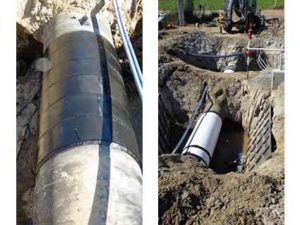Corrosion: The Hidden Culprit Behind the Wyoming Oil Spill In May, corrosion was identified as the primary culprit behind an oil spill in Wyoming. The incident began when a backhoe accidentally struck a 6-inch underground pipeline, creating a small nick that went unnoticed. Over time, this damage worsened due to corrosion, culminating in a catastrophic rupture. It’s unclear exactly how long it took for the initial damage to escalate into a full-blown spill, but the end result was a massive release of 25,000 gallons of crude oil into the Powder River Basin. The oil spread over more than two miles before being contained by a temporary dam erected near the Powder River to prevent further contamination. Cleanup Efforts and Environmental Impact According to Bob Dundas, the environmental coordinator at the Bureau of Land Management (BLM), cleanup efforts were largely effective. Initially, the BLM considered using vacuum trucks to remove the spilled oil, but they ultimately opted for controlled burning as a faster and more efficient way to manage the spill. This decision was made in part because the spill occurred on federal and state lands, minimizing risks to private property. While some petroleum residue lingered in the soil for several weeks, thankfully, the local groundwater remained unscathed. Although the spill wasn’t classified as a major disaster, it serves as a stark reminder that such incidents can—and should—be avoided. Timely intervention after the initial damage could have mitigated the corrosion and prevented the rupture. Conventional repair methods like steel welding or complete pipeline replacement are expensive and time-intensive. Fortunately, there are now innovative solutions that offer cost-effective alternatives without requiring replacement. Innovative Carbon Fiber Repairs HJ3’s CarbonSeal™ carbon fiber repair systems represent a game-changing approach to fixing pipelines compromised by corrosion or physical damage. These carbon fiber composites meet rigorous standards set by the American Society of Mechanical Engineers (ASME) for repairing pressure equipment and piping. Carbon fiber is incredibly strong, with a strength tenfold greater than fiberglass systems, allowing for thinner applications while maintaining durability. Installation is quick, reducing downtime, and the entire process is cost-efficient. Since the introduction of the original ASME/PCC-2 compliant CarbonSeal system in 2008, HJ3 Composite Technologies has successfully repaired thousands of linear feet of pipelines. Their systems have consistently saved pipeline owners up to 90% in repair costs compared to traditional replacement methods. This makes carbon fiber repair a practical and sustainable option for addressing pipeline vulnerabilities. Prioritizing Prevention Preventing pipeline ruptures requires both vigilance and innovation. Oil refineries and maintenance teams must adopt carbon fiber repair techniques as part of their routine maintenance strategies. Regular inspections are critical for catching early signs of corrosion or damage before they lead to catastrophic failures. Investing in these preventative measures not only protects the environment but also safeguards the long-term integrity of critical infrastructure. As we reflect on this incident, it becomes clear that the tools to prevent similar spills already exist. By embracing advanced repair technologies and prioritizing regular inspections, we can ensure that pipelines remain safe and operational for years to come. The spill in Wyoming underscores the importance of staying ahead of potential threats, whether they stem from corrosion or human error. Looking forward, it’s imperative that industries adopt proactive measures to protect our natural resources. Whether it’s through improved inspection protocols or embracing cutting-edge repair solutions like carbon fiber systems, the path to safer pipelines lies in innovation and preparedness. After all, prevention is always better than cleanup. JiangSu Speeder heavy machinery Co., LTD , https://www.speederjoint.com